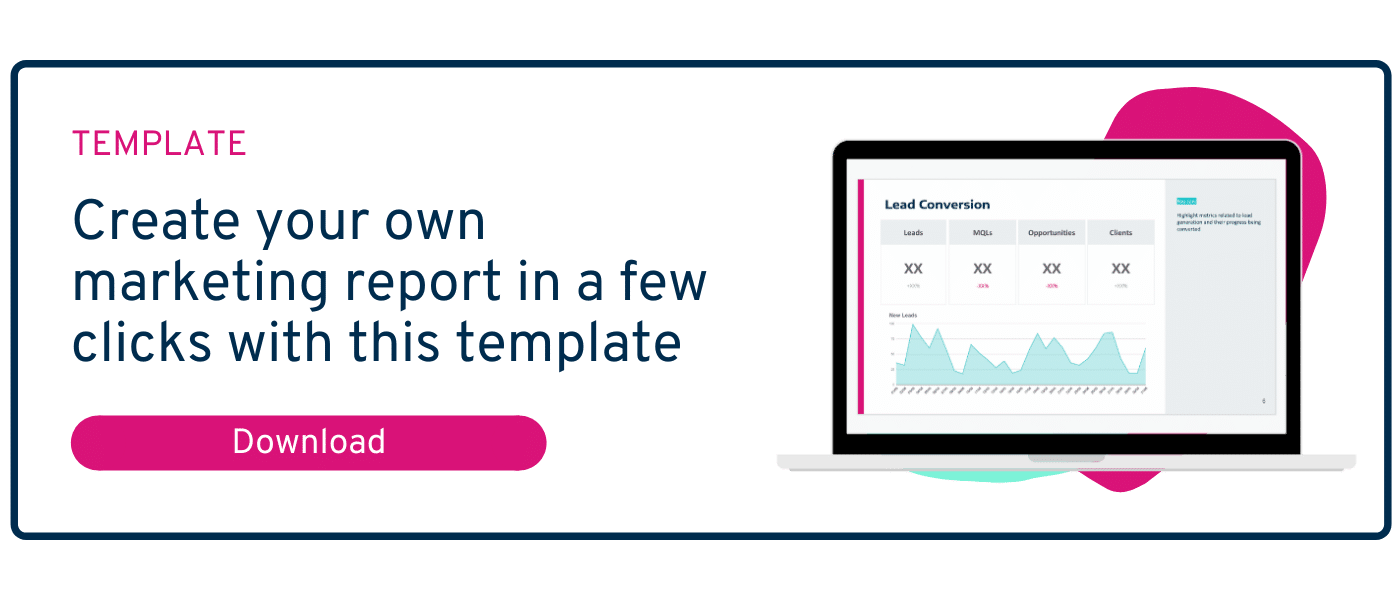Knowing if you are getting value for money from your marketing is key to any successful marketing strategy.
That’s why you need to measure the return on investment (ROI) of marketing. This metric lets you measure how successful your marketing strategy is over time. It will also let you make better business decisions in the future. Whether you are a marketer or CEO, having this information will help you understand how well your business is doing and what areas can be improved in order to reach your marketing goals.
But for every pound that you spend on marketing, exactly how much should you expect in return? We’ll tell you everything you need to know in the post below.
In this post, we’ll look at:
1. A definition of what marketing ROI is
2. Why you need to measure your ROI
3. How to calculate marketing ROI in 5 easy steps
4. When to calculate marketing ROI
5. What is a good marketing ROI?
6. What your ROI can tell you about your business
Definition of marketing ROI
Return on investment (ROI), is a key performance indicator (KPI) that you need to be very familiar with as a marketing manager.
It’s one of the most important figures – if not the most important – that you need to be able to justify to your executive team. And that’s normal because it’s used to determine how cost-effective your business’s investment in marketing is.
You can calculate it using the following formula:
[(Return – Expenses) / Expenses] x 100 = ROI (expressed as a percentage)
As an example, let’s say your company invested 100 pounds in marketing in Q1 and all of your marketing actions combined generated 400 pounds in sales revenue. To calculate your ROI, you would make the following calculation: [(400-100) / 100] x 100 = 300% ROI.If the result is a positive number, you’ve seen a return on your investment; if it’s negative, you’ve lost money on your investment.
Why you need to measure your ROI
1. To justify your marketing expenses
To safeguard the budget and resources of future campaigns, it’s vital that you can justify your current marketing expenses to the executive team.
Being able to accurately show the return on a company’s investment in marketing is a way of ensuring you will have the resources necessary to continue with your chosen marketing strategy.
Let’s say that you’ve invested in a marketing automation tool (Plezi, for example). Being able to show that this helps make your marketing actions more successful, and your business more profitable, will increase executive confidence in spending time and money on future marketing actions.
2. To measure the success of campaigns and marketing channels
Measuring marketing ROI will also help set benchmarks for future marketing efforts.
For example, you launch 2 or 3 different campaigns to promote an upcoming event organized by your company. Once the campaigns have finished, you evaluate which one performed best.
By showing how many event registrations each campaign produced, you can immediately see which one gave you the best ROI and develop that campaign for future events.
3. To better allocate marketing budgets
Knowing which marketing efforts generate the most revenue will let you correctly allocate your marketing budget.
If you find that the ROI of a particular part of your marketing strategy isn’t great, this will let you better allocate funds going forward based on what works. In other words, marketing ROI will show you where you should be spending your money.
4. To provide more accurate forecasts for future marketing efforts
Knowing how much revenue each pound invested in marketing has produced is crucial when planning your marketing strategy for the month, quarter, or year to come. This will also let you continue to increase your ROI over time.
This is the best way to convince your executive team to increase marketing’s budget!
How to calculate marketing ROI in 5 easy steps
1. Set clear goals and decide on the metrics to track
You’ll be much more likely to achieve your goals if they’re clearly defined and measurable.
There are two ways of looking at B2B marketing ROI.
The first, and most typical, is to track how many leads generated by marketing became customers during the current period, and how much those new customers were worth for your business.
The second is to focus on Return on objective (ROO). This enables marketing teams to demonstrate the impact of campaigns when they can’t be directly tied to sales. It is only used to calculate marketing ROI at a later stage.
That’s because ROI measures direct sales results, while ROO answers the question, who took the desired action? It can be used for metrics like the number of MQLs generated, newsletter sign-ups, or numbers of visitors who filled in an online form for example.
This is a very important metric in B2B, where the sales process is longer than in B2C and highly dependent on lead nurturing. For example, if your company is trying to grow its audience on LinkedIn, you can calculate the ROO to determine how successful you have been in terms of engagement.
When you measure ROI, also be sure to avoid using vanity metrics.
2. Track conversions
Keeping a close eye on your conversions will enable you to increase your advertising expenses in a predictable way and determine how cost effective your actions are.
To do this, you’ll need tools like Google Analytics, UTM trackers, and a marketing automation tool. This will let you create campaign-specific links using Google’s URL builder so that the resulting data is included in your Google Analytics reports.
Depending on your conversion goals, the metrics to track include:
- Number of leads generated (who have taken the desired action);
- Number of new customers (leads that have become customers);
- Customer Acquisition Cost (CPC);
- Cost per Lead;
- Conversion rate.
Knowing your conversion rate and cost per lead will ensure that the cost of generating new leads and making a sale is not too high.
If you use Plezi, tracking the numbers of conversions is easy. You can find these figures in your marketing automation tool.
Take, for example, Plezi’s advertising campaigns, We’re interested in the number of leads that come from each channel (e.g., Facebook, LinkedIn, search engines). The problem is that each ad network has its own definition of what counts as a conversion, and we’re more interested in the number of new leads than the total number of conversions.
The reports in Plezi let me see how all our channels have performed according to the same metric, i.e., the number of new leads generated.
(Example of Plezi’s dashboard)
We then compare these with the amount spent on each channel to calculate our cost per lead. Similarly, by integrating Plezi and our CRM, we can accurately track the number of customers that have come from Twitter, search engines, and other channels. This not only provides us with an accurate ROI for our advertising campaigns, but also lets us judge the quality of leads generated on each channel.
3. Calculate the results of your marketing campaigns
The next step is to assign a monetary value to your conversion goals.
- If the goal of your campaign is direct sales, the monetary value is the revenue generated by these sales.
- If the goal of your campaign is to generate leads, you’ll need to calculate the average monetary value of these leads based on historical data or your experience.
Example: You are a publisher of project management software, and you’ve just created a “Guide to the best project management software to use in 2022“. Based on your different pricing plans, your customers spend on average 400 pounds a month, and on average 1 person out of 10 who has downloaded your guide (a lead generated) then becomes a customer. The average value of a lead is therefore 400/10 = 40 pounds.
To calculate the results of your marketing actions, multiply the number of conversions by the defined monetary value.
4. Measure your marketing expenses and investments
Here, you need to include everything that can be considered a marketing expense.
- Advertising campaign budgets (e.g., Google Ads, Facebook Ads, LinkedIn Ads);
- The cost of your marketing tools (e.g., marketing automation, CRM, form builder, landing page builder);
- The cost of inbound marketing actions (e.g., writing blog articles and premium content, shooting and editing videos);
- Other expenses related to content creation (e.g., camera, microphone);
- The cost of time spent by the marketing team.
5. Calculate the ROI
Now that you have figures for revenue and expenses, you have all the information you need to calculate the return on investment. You can calculate it using the following formula:
[(Return – Expenses) / Expenses] x 100 = ROI (expressed as a percentage)
The ROI measures how much revenue a campaign brings in for every pound spent. For example, if you spend 1,000 pounds on a campaign that generated 5,000 pounds in sales, your ROI is 4,000 pounds, or 400%.
When to calculate marketing ROI
You need to remember that the sales cycle in B2B is generally long. This requires some patience. It can take several months before you know if a campaign has been cost-effective.
- The last day of a campaign isn’t the best time to analyse your results, because it’s very likely that some potential buyers won’t have signed up yet. Doing so would skew your results.
- It can be a good idea to treat leads in terms of cohorts. If you generate a lead in March but they finally become a customer in June, they should be assigned to actions undertaken in March. These actions in March are what enabled this lead to be converted into a customer.
You generally need to be patient and wait until the end of the quarter or half-year to calculate your ROI. This will give you a more comprehensive view of how your lead nurturing strategy has performed.
What is a good marketing ROI?
It might seem obvious, once you’ve studied the figures and KPI’s, a good ROI should first and foremost be greater than the cost of your investment in marketing.
The ideal ROI will largely depend on the specific goals of your business. A campaign designed to increase brand awareness will almost inevitably have a low ROI. While a campaign to generate leads should have an ROI that is quite high.
In addition, your ROI will also vary according to the cost structure of your business and your sector of activity.
Generally speaking, an ROI of 500%: is considered very good for most companies, while an ROI of 1000% would be considered exceptional.
On the other hand, a marketing ROI of 200% is too low for many companies, because this means that marketing costs represent around 50% of the sales price.
What your ROI can tell you about your business
Once you’ve calculated your ROI, you can use it to help you plan your future marketing campaigns. You can use it to identify:
- The most effective channels;
- The campaign formats that work best;
- The best periods/times during the year for marketing actions;
- The best marketing actions to undertake at specific periods;
- The most effective marketing strategies;
- How your leads and customers behave.
You need to be able to justify the investment your business makes in marketing. As a result, you need to know how cost-effective each marketing strategy that you use is. The good news is that you can measure the return on investment of each strategy. This knowledge can help you better manage your marketing budget and in turn generate better results. And the decisions you make based on this information will help make your marketing strategies even more effective in the future.







